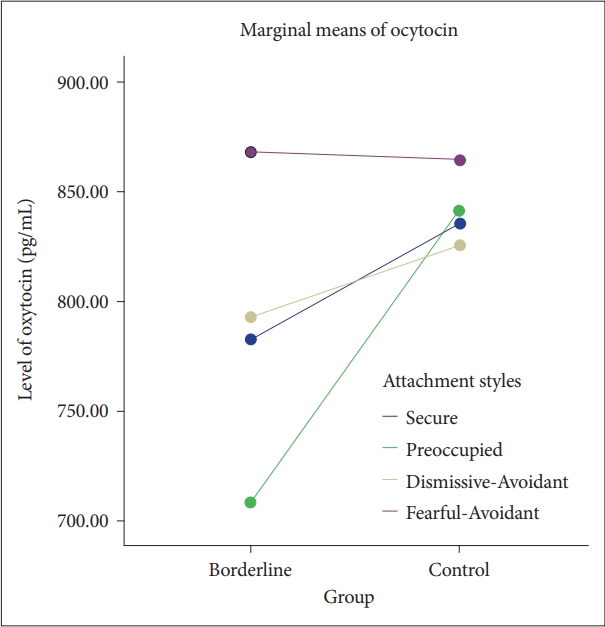1. American Psychiatric Association. Diagnostic and statistical manual of mental disorders: DSM-5. 5th ed. Arlington: American Psychiatric Association; 2013.
2. Zeigler-Hill V, Abraham J. Borderline personality features: instability of self-esteem and affect. J Soc Clin Psychol 2006;25:668-687.

3. De Moor MH, Distel MA, Trull TJ, Boomsma DI. Assessment of borderline personality features in population samples: is the Personality Assessment Inventory-Borderline Features scale measurement invariant across sex and age? Psychol Assess 2009;21:125-130.


4. Kring AM, Johnson SL, Davison Gerald C, Neale JM. Anormal Psikolojisi: Psikopatoloji. Istanbul: Nobel Yayıncılık; 2017.
5. Lynch TR, Rosenthal MZ, Kosson DS, Cheavens JS, Lejuez CW, Blair RJR. Heightened sensitivity to facial expressions of emotion in borderline personality disorder. Emotion 2006;6:647-655.


6. Foxhall M, Hamilton‐Giachritsis C, Button K. The link between rejection sensitivity and borderline personality disorder: a systematic review and meta‐analysis. Br J Clin Psychol 2019;58:289-326.


7. Ozen DS, Guneri FK. Basic determinant of success of interpersonal relationship: rejection sensitivity. Psikiyatride Guncel Yaklasimlar - Curr Approach Psychiatry 2018;10:454-469.
8. Say GN, Müjdeci M. Oxytocin and psychiatric disorders. Psikiyatride Guncel Yaklasimlar - Curr Approach Psychiatry 2016;8:102-113.
9. Bertsch K, Schmidinger I, Neumann I D, Herpertz SC. Reduced plasma oxytocin levels in female patients with borderline personality disorder. Horm Behav 2013;63:424-429.


10. Brüne M, Ebert A, Kolb M, Tas C, Edel M A, Roser E. Oxytocin influences avoidant reactions to social threat in adults with borderline personality disorder. Hum Psychopharmacol 2013;28:552-561.


11. Downey G, Feldman SI. Implications of rejection sensitivity for intimate relationships. J Pers Soc Psychol 1996;70:1327-1343.


12. Göncü Köse A, Özen-Çıplak A, Ulaşan-Özgüle ET, ve Sümer N. [Adapting Rejection Sensitivity Questionnaire into Turkish]. Nesne Psikolojisi 2017;5:383-403. Turkish.
13. Griffin DW, Bartholomew K. Models of the self and other: fundamental dimensions underlying measures of adult attachment. J Pers Soc Psychol 1994;67:430-445.

14. Sümer N, Güngör D. [Adult attachment styles scales on the Turkish sample; psychometric assessment and an intercultural comparison]. Türk Psikoloji Dergisi 1999;14:71-106. Turkish.
15. Bernstein DP, Fink L, Handelsman L, Foote J, Lovejoy M, Wenzel K, et al. Initial reliability and validity of a new retrospective measure of child abuse and neglect. Am J Psychiatry 1994;151:1132-1136.


16. Şar V, Öztürk E, Ikikardes E. Validity and Reliability of the Turkish Version of Childhood Trauma Questionnaire. Türkiye Klinikleri J Med Sci 2012;32:1054-1063.

18. Brüne M. On the role of oxytocin in borderline personality disorder. Br J Clin Psychol 2016;55:287-304.


19. Herpertz SC, Bertsch K. A new perspective on the pathophysiology of borderline personality disorder: a model of the role of oxytocin. Am J Psychiatry 2015;172:840-851.


20. Stanley B, Siever LJ. The interpersonal dimension of borderline personality disorder: toward a neuropeptide model. Am J Psychiatry 2010;167:24-39.


21. Valstad M, Alvares GA, Egknud M, Matziorinis AM, Andreassen OA, Westlye LT, et al. The correlation between central and peripheral oxytocin concentrations: a systematic review and meta-analysis. Neurosci Biobehav Rev 2017;78:117-124.


23. Olff M, Frijling JL, Kubzansky LD, Bradley B, Ellenbogen MA, Cardoso C, et al. The role of oxytocin in social bonding, stress regulation and mental health: an update on the moderating effects of context and interindividual differences. Psychoneuroendocrinology 2013;38:1883-1894.


24. Kutlu MA. [Borderline personality disorder: a review]. Journal of Civilization Studies 2018;3:11-20. Turkish.
25. Sansone RA, Lam C, Wiederman MW. The relationship between illegal behaviors and borderline personality symptoms among internal medicine outpatients. Compr Psychiatry 2012;53:176-180.


27. Frías Á, González L, Palma C, Farriols N. Is there a relationship between borderline personality disorder and sexual masochism in women? Arch Sex Behav 2017;46:747-754.


28. Bertsch K, Gamer M, Schmidt B, Schmidinger I, Walther S, Kästel T, et al. Oxytocin and reduction of social threat hypersensitivity in women with borderline personality disorder. Am J Psychiatry 2013;170:1169-1177.


29. Hammen C, Bower J E, Cole SW. Oxytocin receptor gene variation and differential susceptibility to family environment in predicting youth borderline symptoms. J Pers Disord 2015;29:177-192.


30. Staebler K, Helbing E, Rosenbach C, Renneberg B. Rejection sensitivity and borderline personality disorder. Clin Psychol Psychother 2015;18:275-283.

31. Horney K. The neurotic personality of our time.
Selma K
İstanbul: Doruk Press; 2007.
32. Horney K. Our spiritual conflicts.
Selçuk B
Ankara: Öteki Yayınları; 2011.
33. Hernandez EM, Trout ZM, Liu RT. Vulnerability-specific stress generation: childhood emotional abuse and the mediating role of depressogenic interpersonal processes. Child Abuse Neglect 2016;62:132-141.


34. Kahya Y. Intimate partner violence victimization and perpetration in a Turkish female sample: rejection sensitivity and hostility. J Interpers Viol 2018;36:4389-4412.

35. Masland SR. Trustworthiness appraisal in borderline personality disorder [dissertation] Cambridge, Harvard University. 2016.
36. Pierce J, Abbey A, Wegner R. Mediators of the association between childhood emotional maltreatment and young adult men’s life satisfaction. J Interpers Viol 2018;33:595-616.

37. Ibrahim DM, Rohner RP, Smith RL, Flannery KM. Adults’ remembrances of parental acceptance-rejection in childhood predict current rejection sensitivity in adulthood. Fam Consum Sci Res J 2015;44:51-62.

38. Rosenbach C, Renneberg B. Rejection sensitivity as a mediator of the relationship between experienced rejection and borderline characteristics. Pers Individ Diff 2014;69:176-181.

39. Schaan VK, Vögele C. Resilience and rejection sensitivity mediate long-term outcomes of parental divorce. Eur Child Adolesc Psychiatry 2016;25:1267-1269.


40. Erozkan A. The childhood trauma and late adolescent rejection sensitivity. Anthropologist 2015;19:413-422.











